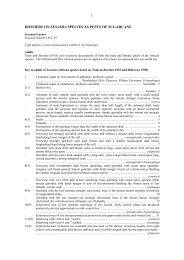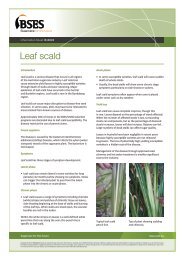You also want an ePaper? Increase the reach of your titles
YUMPU automatically turns print PDFs into web optimized ePapers that Google loves.
MONiTOriNG<br />
Childers canegrub life cycle<br />
Eggs Early instars<br />
Late instars<br />
Dec<br />
Jan -<br />
Mar<br />
GRUB<br />
SAMPLE<br />
Apr -<br />
May Jun -<br />
Sep<br />
Oct -<br />
Apr<br />
DAMAGE<br />
SURVEY<br />
Monitoring allows growers to make<br />
informed decisions on future canegrub<br />
management. The process could involve<br />
monitoring numbers of canegrubs or signs<br />
of their presence– ideally it would be best<br />
to monitor both numbers of grubs and<br />
levels of damage.<br />
A monitoring system for greyback<br />
canegrub in central and northern<br />
Queensland is outlined in the<br />
GrubPlan 2007 booklet, available on the<br />
<strong>BSES</strong> website. We have developed models<br />
to predict numbers of greyback canegrubs<br />
one year ahead, using monitoring<br />
information. Grower groups near Mackay<br />
(Mount Kinchant) and Gordonvale have<br />
been testing this system over the past two<br />
years while a new group is starting this<br />
year in the Herbert – all with funding<br />
from SRDC.<br />
In southern Queensland, there are<br />
numerous types of canegrubs with either<br />
1-year or 2-year life cycles. In the past,<br />
monitoring of 2-year species such as<br />
Childers canegrub in ratoons has focused<br />
on checking for grubs in spring, after<br />
harvest. The disadvantage of monitoring<br />
grubs in spring is that there is little time<br />
May -<br />
Sep<br />
Oct Nov<br />
Adults fly Egg<br />
lay<br />
Dec<br />
Pupation<br />
3 4<br />
fIGuRE 3<br />
Grubs/stool - Spring<br />
10<br />
Timing of monitoring and damage<br />
assessment for Childers canegrub.<br />
fIGuRE 4<br />
Strong relationship between numbers<br />
of Childers canegrubs counted in<br />
canefields in autumn and the following<br />
spring-summer, 2005.<br />
IMAGE 5<br />
Greyback cane beetles feeding on fig<br />
tree leaves.<br />
for planning management strategies,<br />
and significant crop damage has already<br />
occured by the time grubs are detected or<br />
insecticide is applied.<br />
A more effective monitoring system<br />
relies on sampling Childers canegrubs in<br />
autumn rather than at the traditional<br />
time in spring – see figure 3.<br />
Detection of grubs in autumn gives plenty<br />
of opportunity for the grower to decide<br />
the most cost-effective option (treat or not<br />
treat, or fallow-crop) and to coordinate<br />
harvest date with the chosen treatment<br />
option as well as other cropping activities<br />
such as fertilising, irrigation and weed<br />
management.<br />
large numbers of Childers canegrubs in<br />
autumn indicate an imperative to harvest<br />
that block reasonably early and then<br />
to treat it immediately, or alternatively<br />
develop another cropping plan.<br />
The correlation between numbers of small<br />
Childers canegrubs that we have found in<br />
autumn and then subsequent numbers of<br />
large damaging grubs in spring-summer has<br />
been strong enough to guide management<br />
decisions – see figure 4.<br />
Monitoring results for southern 1-year<br />
canegrub (a 1-year species) must be<br />
8<br />
6<br />
4<br />
2<br />
R<br />
0<br />
0 2 4 6 8 10<br />
Grubs/stool - Autumn<br />
2 = 0.7<strong>25</strong>7<br />
interpreted differently from results with<br />
Childers canegrub. With southern 1-year<br />
canegrub, the grubs counted in autumn<br />
are a different generation from those<br />
that may damage the cane the next<br />
season. However numbers of southern<br />
1-year canegrub usually increase from<br />
year to year if unchecked, so grubs in<br />
moderate numbers this year often spell<br />
trouble for next year.<br />
An SRDC-funded grower group at Isis will<br />
further test these monitoring systems for<br />
Childers and southern 1-year canegrubs<br />
over the next 2 years.<br />
Acknowledgment: This project was<br />
funded by <strong>BSES</strong> limited, SRDC, and the<br />
Queensland Government through the<br />
Department of Employment, Economic<br />
Development and Innovation.<br />
[A monitoring<br />
system for greyback<br />
canegrub in central<br />
and northern<br />
Queensland is<br />
outlined in the<br />
GrubPlan 2007<br />
booklet, available<br />
on the <strong>BSES</strong><br />
website.]<br />
p 1 3 i s s u e 2 5




